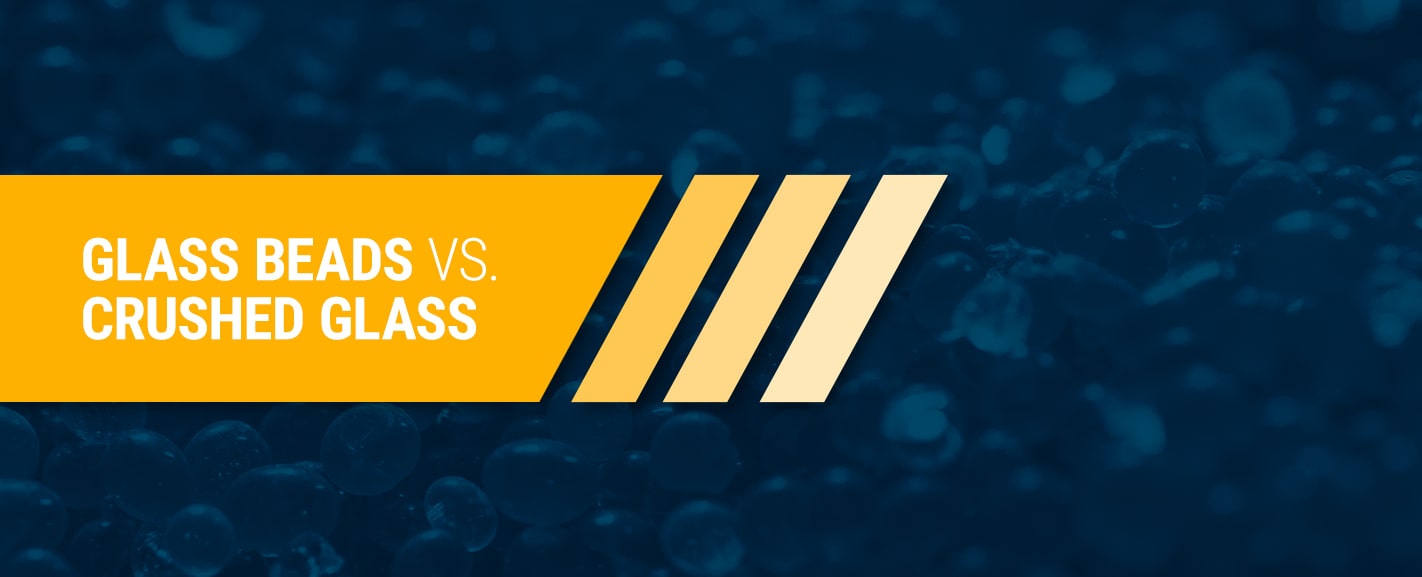Glass Beads vs. Crushed Glass

Glass Beads vs. Crushed Glass
Last Updated: October 17, 2023When it comes to achieving the perfect finish on your materials, glass beads and crushed glass are two popular choices. Both are made from glass and serve as effective abrasives, but they differ in their applications and outcomes. Glass beads are often used in blast cabinets or reclaimable types of blasting operations. They create a consistent, bright matte finish on aluminum and steel surfaces. On the other hand, crushed glass is ideal for stripping away heavy coatings, rust, and paint layers to reveal a clean, bare surface.
Choosing between these two abrasives depends on the specific requirements of your project. If you're unsure which option suits your needs best, weighing the pros and cons of each can help guide your decision-making process.
For more information or assistance, feel free to reach out to us.
Why Choose Glass Beads?
Glass beads excel in finishing tasks involving metals. They are versatile and can be used for various purposes, including frosting and etching glass:
- Cleaning: Great for preparing surfaces without altering tolerances or introducing ferrous contaminants.
- Finishing: Different bead sizes offer a variety of surface finishes and can smooth out machining marks.
- Peening: Helps reduce tensile stress in metal components, enhancing fatigue resistance.
- Deburring: Efficiently removes burrs while maintaining part integrity, resulting in a smooth surface.
An added advantage of using glass beads is their eco-friendly nature—they contain no free silica, unlike traditional sandblasting media which can release harmful substances during the process. As regulations tighten around worker safety, many companies are moving away from silica sand toward safer alternatives like glass beads.
Factors such as bead size, workpiece geometry, nozzle distance, air pressure, and blast system type significantly impact the final outcome and how much media you’ll consume. Proper recycling of glass beads is possible if handled correctly. Investing in a sandblast cabinet can aid in recovering this material for reuse, saving both time and resources.
Overall, glass beads represent an excellent choice for improving efficiency and cost-effectiveness. With a broad spectrum of sizes available, you can achieve the exact finish needed for your parts. Seasoned suppliers can assist you in choosing between coarse and fine glass beads tailored to your application.
No matter which type of glass beads you opt for, they all contribute to creating a bright, smooth, and satin-like finish.
Why Select Crushed Glass?
Crushed glass, because of its irregular shape, creates a stronger etching effect compared to glass beads. This makes it suitable for prepping surfaces where subsequent coatings will be applied. Our crushed glass stands out in numerous applications due to its performance, health, and environmental advantages over other abrasives.
- Recycled: Made entirely from reclaimed glass, it can be reused multiple times and disposed of safely.
- Environmentally Friendly: Non-toxic characteristics minimize pollution risks.
- Non-Reactive: Chemically inert, preventing rust formation and ensuring safe use near water sources.
- Low Silica Content: Contains less than 1% free silica versus up to 99% in silica sand.
- Safe Ingredients: Does not include beryllium, a hazardous metal present in some other abrasives.
- Attractive Finish: Leaves behind a natural, white post-blast appearance.
- Reduced Embedment Issues: Occurs far less frequently than in slag-based media.
- Translucent: Enhances visibility and boosts productivity during operations.
- Lightweight: Lower density means reduced material usage and lower operational costs.
- Approved Standards: May meet QPL or CARB standards depending on production facility.
- Regulatory Compliance: Meets SSPC AB-1 Class A and MIL-A-22262B(SH) criteria based on toxicity evaluations.
Though both abrasives are frequently employed to refine metallic surfaces, sandblasting and abrasive blasting cater to different scenarios and projects. Using glass beads for sandblasting isn’t typical, yet crushed glass blasting media works well with standard sandblast pots.
Grades and Profiles
Crushed glass comes in varying sizes, each producing distinct Mil finishes.
MEDIUM 1.0 – 2.5 MILS : Standard 2.3 MIL (SSPC-AB1 Grade 2)
Effective for cleaning and polishing to yield a smooth, white finish. Perfect for automotive detailing, dustless blasting, and as an alternative to soda blasting.
MEDIUM – COARSE 2.5 – 3.5 MILS : Standard 3.1 MIL (SSPC-AB1 Grade 3)
Appropriate for bridges, storage tanks, steel structures, and precast concrete projects.
COARSE 3.5 – 4.5 MILS : Standard 3.8 MIL (SSPC-AB1 Grade 4)
Best suited for bridges, tanks, steel construction, precast concrete, and situations requiring a deeper profile.
Select Your Glass Abrasives From Finishing Systems
Finishing Systems is renowned as a leading provider of glass bead and crushed glass abrasives. We cater to businesses of all sizes across a wide array of industries, offering tailored solutions to meet diverse needs. Whether you aim to remove paint or eliminate rust, our equipment ensures optimal results without compromising the integrity of the material.
For further details regarding glass beads, crushed glass, or other abrasives, don’t hesitate to contact us today!
Feel free to share this article with others who might find it useful. Understanding the differences between glass beads and crushed glass could save them time and money when selecting the right abrasive for their next project.
TP Full-flexible Central Drainage Hose
Tp Full-Flexible Central Drainage Hose,Flexible P-Trap Drain Pipe,Tp Drain,Drain Hose For Central Air Conditioner
Hebei no one but god energy equipment co.,ltd , https://www.p-harcourtbrothers.com